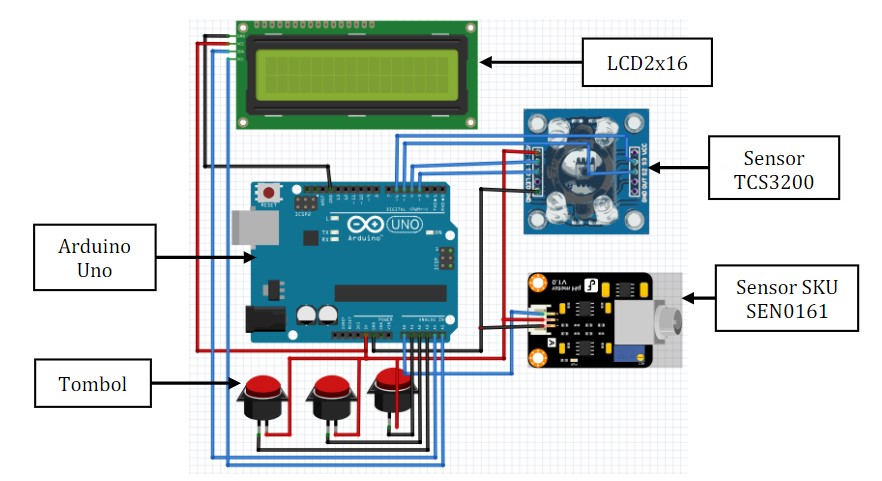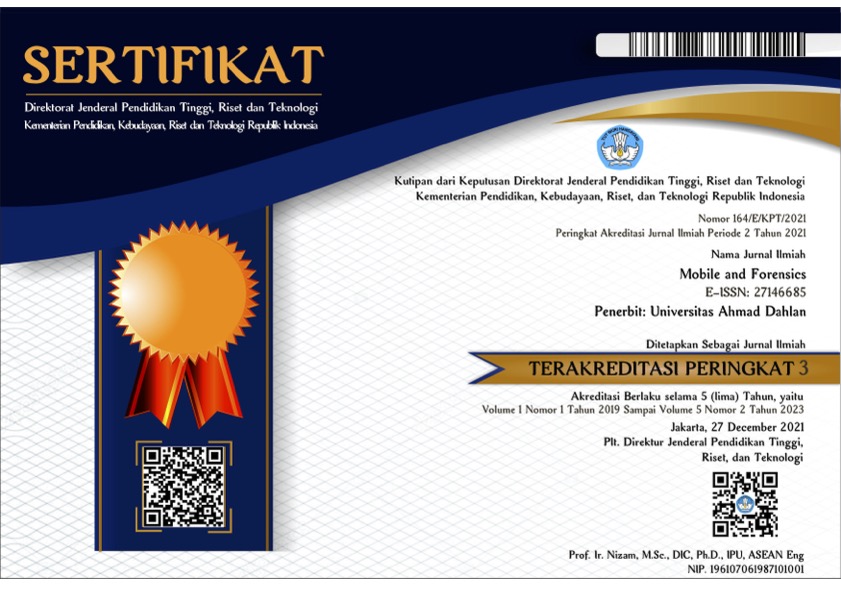Urinoir Analyzer Pintar Pendeteksi Kelainan Pada Fungsi Ginjal Dengan Analisis Kadar Ph Dan Warna Pada Urin
DOI:
https://doi.org/10.12928/mf.v2i1.2032Keywords:
TCS3200, PH meter SKU SEN0161, Penganalisis Urin, Keabuan, Kelainan GinjalAbstract
Perkembangan pemeriksaan penyakit kelainan ginjal melalui analisa urin saat ini dilakukan dalam dua proses pemeriksaan secara makroskopis dan mikroskopis. Pada dasarnya dibutuhkan sebuah alat yang mampu memproses dan menganalisis sebuah sampel urin secara otomatis agar tidak terjadinya kesalahan dalam melakukan pemeriksaan penyakit melalui sampel urin. Awalan perkembangan ini menggunakan sebuah Kontroler Arduino UNO dan dua buah variabel masukan yaitu sensor warna TCS3200 dan sensor PH meter SKU SEN0161. Dua buah variabel masukan sensor bekerja secara berdampingan dengan sensor TCS3200 memiliki hasil keluaran berupa nilai frekuensi RGB dan diproses kembali menjadi frekuensi keabuan. Lalu, sensor PH meter SKU SEN0161 menghasilkan sebuah nilai PH pada sampel urin. Hasil dari pemeriksaan tersebut ditampilkan pada sebuah penampil berupa LCD berukuran 16x2. Hasil pemeriksaan dari alat ini dibandingkan dengan hasil analisa pakar dari Balai Laboratorium Kesehatan Yogyakarta bagian Urology. dan mendapatkan tingkatan nilai akurasi 93% dengan keberhasilan data sebanyak 28 dari 30 data yang diambil.
The development of examining kidney disorders through urine analysis is currently carried out in two processes of examination, macroscopic and microscopic. Basically, we need a tool that is able to process and analyze a urine sample automatically so that there are no errors in carrying out disease checks through the urine sample. The beginning of this development used an Arduino UNO controller and two input variables, namely the TCS3200 color sensor and the SKU SEN0161 PH meter sensor. Two sensor input variables working side by side with the TCS3200 sensor have an output in the form of RGB frequency values and are processed back into gray frequencies. Then, the PH meter SKU SEN0161 sensor generates a PH value in the urine sample. The results of these checks are displayed on a 16x2 LCD display. The examination results of this tool are compared with the results of the analysis of experts from the Yogyakarta Health Laboratory Center, Urology section. and get an accuracy level of 93% with the success of the data as much as 28 of the 30 data taken.
References
J. Fisika and D. Aplikasinya, "Investigasi Difusi pada Sistem Urinari untuk Gangguan Fungsi Ginjal Model Empat Kompartemen menggunakan Metode Monte Carlo," iptek.its.ac.id, vol. 16, no. 1, pp. 24-28, 2020.
D. Delima and E. Tjitra, "Faktor Risiko Penyakit Ginjal Kronik : Studi Kasus Kontrol di Empat Rumah Sakit di Jakarta Tahun 2014," Buletin Penelitian Kesehatan, vol. 45, no. 1, pp. 17-26, Mar. 2017.
F. Agung Rakhmadi, Karmanto, and I. Nugraheni Ari Martiwi, "Rancang Bangun Instrumen Urine Analyzer System Berbasis Resistansi bagi Analisis Gangguan Fungsi Ginjal," Integrated Lab Journal, vol. 5, no. 1, pp. 19-28, 2017.
R. Yaswir, I. F.-J. K. Andalas, and U. 2012, "Fisiologi dan gangguan keseimbangan natrium, kalium dan klorida serta pemeriksaan laboratorium," Jurnal Kesehatan Andalas, vol. 1, no. 2, pp. 80-85, 2012.
R. Loesnihari, "Tinjauan Pustaka Peran analisa urin pada penanganan penyakit ginjal dan traktus urinarius," 2012.
I. Mudzaki, R. Alfita, and M. Ulum, "Rancang Bangun Smart Urinoir Untuk Mendeteksi Status Dehidrasi Berbasis Image Processing Dengan Metode Jaringan Syaraf Tiruan Perceptron," Apr. 2020.
R. I. Putra, S. Sunardi, and R. D. Puriyanto, "Monitoring Tegangan Baterai Lithium Polymer pada Robot Line Follower Secara Nirkabel," Buletin Ilmiah Sarjana Teknik Elektro, vol. 1, no. 2, p. 73, 2019.
A. I. Bardani and N. S. Widodo, "Deteksi Zona pada KRSTI dengan Sensor Warna TCS3200," Buletin Ilmiah Sarjana Teknik Elektro, vol. 1, no. 2, p. 56, 2019.
S. Roy, A. Mitra, and S. K. Setua, "Color & grayscale image representation using multivector," in Proceedings of the 2015 3rd International Conference on Computer, Communication, Control and Information Technology, C3IT 2015, 2015.
D. S. Rint Zata Amani, Rizal Maulana, "Sistem Pendeteksi Dehidrasi Berdasarkan Warna dan Kadar Amonia pada Urin Berbasis Sensor TCS3200 Dan MQ135 dengan Metode Naive Bayes | Jurnal Pengembangan Teknologi Informasi dan Ilmu Komputer," Jurnal Pengembangan Teknologi Informasi dan Ilmu Komputer, vol. 1, no. 5, pp. 436-444, 2017.
Verdiansah, "Pemeriksaan Fungsi Ginjal," Cermin Dunia Kedokteran, vol. 43, no. 2, pp. 148-154, Feb. 2016.

Downloads
Published
Issue
Section
License
Copyright (c) 2020 M. Iqbal Febryansah, Anton Yudhana, Alfian Ma'arif

This work is licensed under a Creative Commons Attribution-ShareAlike 4.0 International License.
Start from 2019 issues, authors who publish with JURNAL MOBILE AND FORENSICS agree to the following terms:
- Authors retain copyright and grant the journal right of first publication with the work simultaneously licensed under a Creative Commons Attribution License (CC BY-SA 4.0) that allows others to share the work with an acknowledgment of the work's authorship and initial publication in this journal.
- Authors are able to enter into separate, additional contractual arrangements for the non-exclusive distribution of the journal's published version of the work (e.g., post it to an institutional repository or publish it in a book), with an acknowledgment of its initial publication in this journal.
- Authors are permitted and encouraged to post their work online (e.g., in institutional repositories or on their website) prior to and during the submission process, as it can lead to productive exchanges, as well as earlier and greater citation of published work.

This work is licensed under a Creative Commons Attribution-ShareAlike 4.0 International License.











 Mobile and Forensics (MF)
Mobile and Forensics (MF)